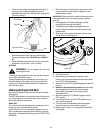
23
Lubrication
WARNING: Before lubricating, repairing, or
inspecting, always disengage PTO, set
parking brake, stop engine and remove key to
prevent unintended starting.
Engine
Refer to Engine on page 19 for instruction regarding all
engine-related lubrication.
Front Wheels
Each of the front wheel axles and rims is equipped with
a grease fitting. See Figure 16. Lubricate with a No. 2
multi-purpose grease applied with a grease gun after
every 25 hours of tractor operation.
Figure 16
Pivot Points & Linkage
Lubricate all the pivot points on the drive system,
parking brake and lift linkage at least once a season
with light oil.
Deck Wheels
Each of the tractor deck’s front gauge wheels is
equipped with a grease fitting. Lubricate with a No. 2
multi-purpose grease applied with a grease gun after
every 25 hours of tractor operation
Deck Spindles
Grease fittings can be found on the front of each deck
spindle shaft. Lubricate with 251H EP grease or an
equivalent No. 2 multi-purpose lithium grease. Using a
grease gun, apply two strokes (minimum) or sufficient
grease to the spindle shaft.
Carburetor
NOTE: Carburetor adjustments should be made only
after the engine has warmed up.
The engines on Cub Cadet Series 1500 tractors are
equipped with a fixed main jet carburetor.
Carburetors are equipped with a idle speed adjustment
screw and a low idle fuel mixture screw.
•
The Fuel Mixture Screw is the uppermost screw.
• The
Idle Speed Adjustment Screw is the lower
screw.
The carburetor is designed to deliver the correct fuel-to-
air mixture to the engine under all operating conditions.
The main fuel jet is calibrated at the factory and is not
adjustable. The low idle fuel mixture screw is also set at
the factory and normally does not need adjustment.
If the engine is hard to start, runs roughly, or stalls at
low idle speed, it may be necessary to adjust or service
the carburetor.
Turning the low idle mixture screw in (clockwise)
decreases the supply of fuel to the carburetor. This
gives a leaner fuel-to-air mixture. Turning the mixture
screw out (counterclockwise) increases the supply of
fuel to the carburetor. This gives a richer fuel-to-air
mixture. Setting the screw midway between the lean
and rich position will usually give the best results.
Troubleshooting
If engine troubles are experienced that appear to be
fuel system related, check the following areas before
adjusting the carburetor.
• Make sure the fuel tank is filled with clean, fresh
gasoline.
• Make sure the fuel tank cap vent is not blocked and
that it is operating properly.
• If the fuel tank is equipped with a shut-off valve,
make sure it is open.
• Make sure that the in-line fuel filter is clean and
unobstructed. Replace the filter if necessary.
• Make sure fuel is reaching the carburetor. Check
the fuel lines and fuel pump for restrictions or faulty
components, replace as necessary.
• Make sure the air cleaner element is clean and all
air cleaner element components are secure.
If, after checking the items listed above, the engine is
hard to start, runs roughly, or stalls at low idle speed, it
may be necessary to adjust or service the carburetor.
Axle Grease Fitting
Rim Grease Fitting


















